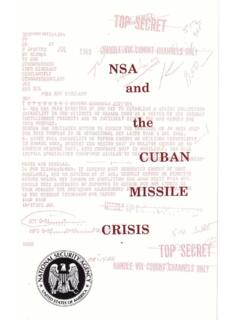Transcription of Social Realism: The Turns of a Term in the Philippines - TFAM
1 Social Realism: The Turns of a Term in the Philippines Patrick D. Flores Somewhere in the Philippines , in the 1970s, the Coca-Cola logo bleeds across the image and becomes the proscenium arch of a theatre of everyday life. In the watercolour Itak sa Puso ni Mang Juan (Dagger in Old Juan's Heart, 1978), Antipas Delotavo depicts a man, slightly stooped, passing by an overwhelmingly large billboard advertising the archetypal product of the United States. The artist seizes on a moment when the multinational and the proletariat inhabited common, contentious ground in the Philippines . The serif of the letter C' appears to nearly touch the fatigued gure, as if ready to cut into his esh, to shed blood that is both always-already owing and foretelling fate.
2 Delotavo explains that he was drawn to the Coke icon because for him it incarnated the ubiquity of the US in the Third World; its internecine interventions in Southeast Asia; and its support for the Ferdinand Marcos regime in the Philippines , which hosted two of the US's largest foreign military bases. Also crucial here is advertising as a vehicle of imperialism, in guaranteeing the US's hegemonic presence in the economy and culture of the Philippines even after it gained independence in 1946, following nearly fty years of US rule and three centuries of Spanish occupation. 1 The Coke logo is concomitantly a cipher of capitalism and, in Delotavo's own words, of cultural enslavement'.
3 2. In 2012, this work was shown in ReCollection 1081: Clear and Present Danger (Visual Dissent on Martial Rule)', an exhibition that commemorated the imposition of Martial Law by Marcos in 1972, 3 one of a series of measures aimed at quelling the communist tide rising within and beyond the Philippines , and with which the regime ultimately tore apart the civil basis of the modern democratic republic the rst to be established, in 1898, in either Asia or Africa. It was surprising to Looking at the legacy of 1970s Social see Delotavo's and other politically charged works from the 1970s gathered together realist painting in the Philippines , at the Cultural Center of the Philippines in Patrick D.
4 Flores re ects on the intersection Manila. After all, this had been the premier of postcolonial discourse, historical edi ce of culture that Imelda Marcos, wife of the strongman, had built in 1969 as the imagination and political art practice. sanctuary for the Filipino soul' and shrine of the Filipino spirit'. 4 The former beauty queen turned urban planner of the City of Man', as she christened Manila, had to recover around 77 hectares of foreshore land to realise her vision, a project unparalleled in the region at that time. She proclaimed loftily: It shall be our Parthenon built in a time of hardship, a spring-source of our people's living conviction in the oneness of our heritage It is highly symbolic that this Center whose mission it is to reclaim from the past the things that belong to our present and our future should stand here on land reclaimed from the sea [so that].
5 Our works in stone and story may remain, for all time, a testament to the goodness, the truth and the beauty of a historic race. 5. 1 The Philippines was the first European and the only US colony in Asia. Spanish colonisation began in the mid-sixteenth century and lasted until 1898, when the US seized control of the country, leading to the Philippine-American War (1899 1913). 2 Conversation with the author, 25 March 2013. 3 ReCollection 1081: Clear and Present Danger (Visual Dissent on Martial Rule)', Cultural Center of the Philippines , Manila, 14 July 30 September 2012. 4 Imelda Marcos, quoted in Ileana Maramag (ed.), The Compassionate Society and Other Selected Speeches of Imelda Romualdez Marcos, Manila: National Media Production Center, 1973, 15.
6 5 Ibid. Contexts: Social Realism in the Philippines | 63. This content downloaded from on Sun, 17 Jan 2016 08:57:40 UTC. All use subject to JSTOR Terms and Conditions It was at the Cultural Center that various types of high-modernist and Conceptual art exhibitions and events were presented under the auspices of a government that staged spectacles of democracy, development and national identity, constructing the country as a Gesamtkunstwerk one in which a new world was deemed to be suddenly turning visible'. 6 Ferdinand Marcos was inspired by the same ideal, ordaining the Center as a place where the Filipino can discover the soul of his people, and relate the saga of his race to the vast human experience that begins in the past and advances into the limitless future'.
7 7 Under Imelda's directorship, the Center strove for a certain world-class' status for Philippine talent based on an understanding of modernism as an aspirational discourse of equivalence. 8 Its programme re ected a cultural policy anchored in an identity at once archaic and contemporary with native and national provenance on the one hand, and modernist inclinations on the other which largely rested on Imelda Marcos's notion of the goodness, the truth and the beauty of a historic race' that necessarily excluded the unsightly ferment or the socio-economic asymmetries of the present. The latter were embodied in turn by Social realism', an aesthetic movement that emerged in the Philippines in the late 1970s.
8 Resisting the idealisation of progress, Social realism articulated a dissident cultural imagination, one wrought throughout centuries of colonialism, and that in many ways persists in postcolonial discourse and practice in the Philippines today. The Kaisahan The belligerence of Delotavo's work is in line with his coterie of artists in Manila, who formed the collective Kaisahan ( Solidarity') in 1976: Papo de Asis, Pablo Baens Santos, Orlando Castillo, Jose Cuaresma, Neil Doloricon, Edgar Talusan Fernandez, Charles Funk, Renato Habulan, Albert Jimenez, Al Manrique and Jose Tence Ruiz; later joined by Vin Toledo. The Kaisahan emerged from a history of efforts by the Left to mobilise the youth as part of a wider struggle against what art historian Alice G.
9 Guillermo has identi ed as the exploitative forces of US imperialism and its local agents' in the Philippines , and which can be understood in the context of the radicalised international student movement of the late 1960s and 70s. 9 The collective has a precedent in the politically motivated Nagkakaisang Progresibong Artista at Arkitekto ( United Progressive Artists and Architects', NPAA), a group that officially formed in 1971 but started to coalesce as early as 1969, when the Kabataang Makabayan ( Nationalist Youth') rst gathered artists amongst their ranks. Informed by the doctrines of Karl Marx, Vladimir Lenin and Mao Tse-Tung, the NPAA was clearly red up by the rousing rhetoric of Jose Maria Sison, Chairman of the Communist Party of the Philippines since 1968 and foremost ideologue of the national democratic movement an assemblage of fronts involving parliamentary and armed struggles under the aegis of the Communist Party.
10 In his message to the founding of the NPAA an acronym quite close to that of the armed wing, the New Peoples Army (NPA) . Sison gave unequivocal marching orders: Any piece of art bears the stamp of a de nite class Grasp the truth that proletarian politics is in command of revolutionary aesthetics.' 10. It is in the crucible of this radicalised student movement, with clear socialist leanings, that the Kaisahan was forged, and their activities played out within a revolutionary context. In 1976, the Kaisahan circulated a manifesto that broadly followed the doctrine of the NPAA. As Guillermo points out, however, it also encapsulated the artists' attempt to reformulate the aesthetics of political art to give it more breadth and room for creativity'.

